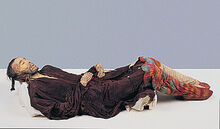The Cherchen man was found at Zaghunluq near the town of Qiemo (Cherchen) in the Taklamakan Desert, Xinjiang Uighur Autonomous Region, western China in 1978. Cherchen man is very well preserved, and it has been estimated that he died approximately 1000 BC. Cherchen Man was found with the mummies of three women and a baby.
Although discovered in China, he is of European descent based on physical features; hair that was "reddish brown flecked with grey, framing high cheekbones", an "aquiline...long nose, full lips and a ginger beard", and was wearing "a red twill tunic" and leggings with a pattern resembling "tartan." Tattoos and symbols discovered on his body also point to a European background.
Mummification[]
Preservation is a result of natural mummification due to arid conditions. Other such remains have also been recovered at sites throughout the Tarim, including Qäwrighul, Yanghai, Shengjindian, Shanpula, and Qizilchoqa. Like other mummies from the Tarim, Cherchen Man was buried in a tomb made of mud bricks topped with reeds and brush.

The desert's dry conditions as well as its salty soil provided a suitable climate for mummification. Extremely cold temperatures would have killed any bacteria that contributed to the decay, and the "thick clothes and socks made of rainbow-colored wool" suggest he was buried in the winter.
Studies[]
The clothing discovered was actually constructed of sheep's wool. Small grains of wheat were also found in the tomb.
Yellow and reddish patterns on the face of Cherchen Man have been identified as tattoos in some sources, but are more likely ochre paint. The man is often described as looking "like a Bronze Age European" or as resembling "a Celt", However, Cherchen Man was more likely connected to the so-called Afanasevo culture – an Indo-European people located in Siberia during the 4th and 3rd Millennia BC. Y-DNA analysis showed that he was Haplogroup R1a, characteristic of western Eurasia. DNA testing confirmed definitively that the Cherchen Man and those buried with him were of European decent. How he ended up in China is still an unsolved mystery.
Grave artifacts include wheat, wool cloths and blankets. He is dressed in a dark suit with red, yellow, and blue stockings with white deerskin boots. Also included were ten hats.
Pathology[]
It is believed that the Cherchen man died during an epidemic that took place in the region. No physical trauma or other signs of injury have been discovered after careful observations.
See Also[]
- Beauty of Loulan
- Beauty of Xiaohe
- Tocharian Child
- Tocharian Woman
- Cherchen Mummies
- Yingpan Man
- Man From Hami
References[]
"ABCNEWS.com : Lee Dye: Secrets of Cherchen Man." ABCNEWS.com : Lee Dye: Secrets of Cherchen Man. N.p., n.d. Web. 30 Nov. 2015.
"Cherchen Man." Chinese Mummies. N.p., n.d. Web. 30 Nov. 2015.
"The Cherchen Man Continues to Remain a Fascinating Figure." The Cherchen Man Continues to Remain a Fascinating Figure. N.p., n.d. Web. 30 Nov. 2015.
- J. Hare, The mysteries of the Gobi Desert. Taylor & Francis, 2009
- (2006). "The Desert Makes MUMMIES". Ask 5(2), 13.
